Please REJOIN Linked In! NPSTC’s Linked In Community Former and New Members, This is For You. Due to a technical error, the NPSTC Community Linked In account was deleted. At the time, NPSTC’s Linked In community hosted 1,134 members. We want you back. Linked-In Customer Service advised that us that the NPSTC community could not be restored, so we are starting over and wish to invite all 1,134 of you who were previously members of our group to rejoin us and bring your colleagues too. Thank you for your patience and understanding over the last 3 weeks as we have been working to restore our presence. Click here to rejoin: http://www.linkedin.com/groups/National-Public-Safety-Telecommunications-Council-6555062
FCC Chairman Wheeler Names Admiral David Simpson PSHSB Chief: FCC Chairman Tom Wheeler announced his intention to name Rear Admiral David Simpson as Chief of the FCC’s Public Safety and Homeland Security Bureau (PSHSB). Admiral Simpson brings more than 20 years of Information and Communications Technology experience supporting the Department of Defense, working closely with other agencies to provide secure communication services and improve cyberdefense readiness.
Chairman Wheeler said, “The FCC plays an essential role in ensuring that public safety agencies have the access to communications needed to fulfill their mission of safeguarding the American public. At a time when our networks are continuously being attacked, it is also important to have someone with Admiral Simpson’s cybersecurity skills. Admiral Simpson’s extensive experience managing and securing complex and disparate information environments worldwide makes him exceptionally well suited to lead PSHSB. He has a proven track record working with a diverse community of government agencies to manage integration of communications systems in challenging environments, and the public safety and network security communities will benefit from that depth of expertise and experience.”
NPSTC Files with FCC on Emission Mask Requirements for Digital Technologies on 800 MHz NSPAC Channels; Analog FM Capability on Mutual Aid and Interoperability Channels. In its Notice of Proposed Rulemaking (NPRM) in this proceeding, the Commission proposes to require digital technologies to comply with Emission Mask H when operated in the 800 MHz National Public Safety Planning Advisory Committee (NPSPAC) band (806-809/851-854 MHz). The Commission also proposes to require equipment to have analog FM capability when operating on 800 MHz, VHF, and UHF public safety mutual aid and interoperability calling channels.
NPSTC concurs with the Commission that these proposals could help safeguard public safety licensees in the NPSPAC band from adjacent-channel interference and help preserve interoperability. NPSTC supports the Commission’s proposal to require the H mask in the 800 MHz NPSPAC channels to minimize adjacent channel interference. NPSTC also supports the Commission’s proposal regarding analog FM interoperability on the five NPSPAC mutual aid channels and the VHF/UHF interoperability calling channels. Click here to view NPSTC’s comments: http://npstc.org/download.jsp?tableId=37&column=217&id=2891&file=NPSTC_Comments_800MHz_NPSPAC_H_Mask_131114.pdf
Wireless Broadband Coalition Projects 700 % Hike in Mobile Data Traffic. A projected 700% hike in mobile data traffic in North America between 2013 and 2019 highlights the need for the U.S. government to make more spectrum available to carriers, according to the Wireless Broadband Coalition. The coalition cited a report released by Ericsson that projects a seven-fold increase in mobile data traffic in North America between this year and 2019. The increases are expected to be even greater – 11 times – in Latin America; Central Europe, the Middle East, and Africa; and the Asia Pacific regions.

